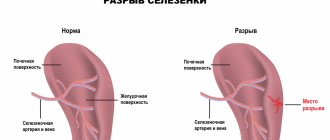The sensitivity of the hands and fingers largely ensures a person’s ability to work and the ability to self-service. If the fingertips lose their usual sensitivity, this invariably affects the fine motor skills of the hands. A person cannot balance the effort required even to hold a cup of tea or a sewing needle. This is a rather unpleasant condition, which, nevertheless, can accompany many pathologies of the musculoskeletal system and the central nervous system.
Very often the little fingers on the hands go numb due to cervical osteochondrosis with total destruction of the intervertebral disc that protects the radicular nerves responsible for the innervation of this limb. At the initial stage of the pathology, the little fingers go numb, and then a total loss of sensitivity begins in the ring, middle, index and thumb. Only competent therapy for cervical osteochondrosis can help. The sooner compression from the dorsal root nerve is removed, the higher the likelihood that full sensation will be returned.
In this article, we suggest learning about why the little finger on the hand goes numb, what causes and treatment exist, and where you can go for timely and effective medical help.
Reasons why the little finger on the hand goes numb
The reasons why the little fingers on the hands go numb may be hidden in different structures of the central and autonomic nervous system of the human body. Loss of sensitivity cannot occur (even short-term) if there is no disturbance in the conduction of nerve impulses.
In order to understand why the little fingers on the hands go numb, you need to delve a little into the anatomy and physiology of the innervation process. So, it is important to know how a nerve impulse is generated, processed and then transmitted along the axon network.
If you look at the reasons from the point of view of anatomy and physiology, then everything looks like this:
- in the thickness of the epidermis there are small nerve endings that can distinguish many environmental parameters;
- after contact with the external environment, these receptors transmit an impulse along the nerve fiber to the spinal cord;
- then the signal enters the analyzing structures of the brain, where a comparative analysis is carried out and recognition occurs (this entire process from contact to obtaining the result takes a fraction of a second, and therefore is not recorded by a person’s attention);
- the reverse process of signal transmission begins, which instructs you to withdraw your hand, squeeze the object harder, adjust the effort, etc.;
- transmission of nerve impulses from brain structures occurs through the spinal canal of the autonomic nervous system;
- radicular nerves depart from the structure of the spinal cord, subdivided into posterior (responsible for sensitivity) and anterior (responsible for motor activity);
- after the analysis result is obtained, the nerve impulse is conducted along the fiber of the posterior root nerve, which is responsible for the sensitivity of the upper limbs and fingers;
- initially this is one root nerve, but as it moves away from the structure of the spinal cord, it branches and is divided into branches responsible for the innervation of individual parts of the arm;
- along the entire path, tunnel obstacles may arise that have a compressive effect on the nerve;
- this causes a feeling of numbness in the little finger of the hand.
Now it becomes more clear why the little finger on the hand goes numb with cervical osteochondrosis? The outgoing dorsal root nerve is subject to partial compression and those afferent axons that reach the tissues of the little finger are affected.
In addition to cervical osteochondrosis, this symptom may accompany the following diseases and pathologies:
- carpal tunnel syndrome;
- deforming osteoarthritis of the wrist and interphalangeal joint;
- osteoarthritis of the elbow joint;
- tendovaginitis and myofascial syndromes;
- consequences of a radial fracture in a typical location with displacement of bone fragments;
- rheumatoid and inflammatory damage to the structure of the cartilage tissue of large and small joints of the upper limb;
- gout and other types of salt deposits in joint cavities;
- sprain of ligament, tendon or muscle fibers in the wrist and palm;
- ruptures, cuts, deep penetrating wounds in the palm area.
If the feeling of numbness was preceded by an injury, then you need to contact a traumatologist, eliminate the need for surgical intervention and follow all the doctor’s recommendations. In the event that there was no injury, but the little finger is numb, it is important to look for the potential cause of the symptom and, if possible, eliminate it. Otherwise, it will be impossible to cure this condition.
How does numbness in the fingers manifest under various conditions?
Typically, numbness is most felt in the fingertips.
| State | Signs |
| Nerve compression, development of the inflammatory process | In addition to numbness, the patient may experience nagging pain and discomfort in the affected limb |
| Atherosclerotic lesion of blood vessels | The person may also experience a tingling or crawling sensation. |
| Cerebrovascular accident | In addition to numbness, the patient may experience headache, dizziness, speech and movement disturbances, muscle weakness, paralysis |
| Complicated cervical osteochondrosis | Numbness of the little and ring fingers on both hands |
| Vitamin deficiency | In addition to numbness of the fingers, peeling of the skin of the palms may occur. |
Why do the little fingers on my hands go numb at night when I sleep?
Many people have noticed that their little fingers go numb during sleep, and the unpleasant sensations arise immediately at the moment of awakening. Very often, this symptom occurs when the structure of the nerve fiber is compressed due to an incorrectly chosen position for night rest. It is important to avoid wearing tight clothing made from rough or non-stretchy fabrics. They can affect the armpit, wrist, and forearm.
The nerves responsible for conducting nerve impulses are reliably protected almost throughout their entire path by muscle fascia. But during night sleep, the human body relaxes and the muscular frame almost completely loses its protective function. Therefore, during sleep, limbs become numb, nerves are easily pressed, and a feeling of numbness occurs.
Unfortunately, most cases where the little finger on the hand goes numb at night indicate that the person has serious pathologies in the cervical spine. And such conclusions are always confirmed by subsequent X-ray images.
As mentioned above, the muscular frame of the body completely relaxes during sleep (with the exception of the respiratory muscles and myocardium). Accordingly, the compensatory function of the muscles of the neck and collar area is lost. If the intervertebral disc is damaged, the muscles in the first and second stages of osteochondrosis easily compensate for the protrusion of cartilage tissue. Therefore, during the period of wakefulness, a person may not even suspect that he has such a disease. During sleep, the neck muscles relax and compression pressure is applied to the radicular nerve. This is why the little fingers on the hands go numb during sleep and then during the day there may be a slight tingling sensation along the lateral part of the forearm.
If you have a similar symptom, we recommend that you seek medical help immediately. In the early stages, osteochondrosis can be cured very quickly and easily. Also, at present, any size, type and location of hernial protrusions can be successfully treated with conservative treatment.
We invite you to a free initial consultation at our manual therapy clinic. Call us and make an appointment at any time convenient for you. The doctor will conduct an examination and manual examination of the cervical spine and upper limb. An accurate diagnosis will be made and recommendations for further treatment will be given.
Numbness as a symptom
Numbness can be caused by:
- pinched nerve. A pinched nerve can occur at the point where it exits the spinal canal ( radicular syndrome
).
Therefore, numbness is a typical symptom of osteochondrosis and other spinal diseases. The nerve can also be pinched in other areas. Pinching of a nerve in its natural canal (tunnel) is defined as tunnel syndrome
.
The most common is carpal tunnel syndrome
(a pinched nerve in the wrist).
In this case, the fingers go numb. Office work (using a keyboard and mouse) contributes to the development of the disease. Also quite common is ulnar nerve neuropathy
, the development of which is facilitated by the need for prolonged support with the elbow (typical of working at a computer).
Wearing a belt, pressing the thigh against the edge of the table, or inconvenient objects in pockets can lead to pinching of the external cutaneous nerve of the thigh ( Roth disease
) - the most common foot tunnel syndrome; - injury. Trauma can disrupt the integrity of nerve fibers, resulting in loss of sensation in the area supplied by the damaged nerve;
problems of peripheral circulation. For example, the development of atherosclerosis of the vessels of the lower extremities leads to disruption of the blood supply to the legs (primarily the feet). A lack of fresh blood flow manifests itself as pale skin, a local decrease in body temperature, and numbness. Numbness may also accompany a violation of the venous outflow of blood (chronic venous insufficiency);- anemia (decreased hemoglobin in the blood). The reasons may be problems with the intake or absorption of iron, vitamins (B12, folic acid);
- polyneuropathy - multiple lesions of peripheral nerves. Polyneuropathy can be a consequence of diabetes mellitus, alcoholism, poisoning, long-term use of certain medications, autoimmune diseases, metabolic disorders and other systemic pathologies;
- diseases of the central nervous system - such as brain tumors, cerebrovascular accidents, multiple sclerosis.
The tip of the little finger on the hand constantly goes numb after work
Another common problem is that the tip of the little finger on the hand goes numb after a hard day's work. This is usually encountered by people who, by the nature of their professional activities, are engaged in monotonous operations involving fine motor skills of the hands.
The little fingers on the hands of programmers and secretaries, managers, hairdressers, painters, plasterers, cooks, confectioners, tailors, seamstresses, nurses, etc. constantly go numb. Computer work and long periods of manual writing can further aggravate this problem.
In this case, the little fingers on the hands become numb due to carpal tunnel syndrome. It lies in the fact that the channel through which the innervation passes narrows under the influence of scar changes on the part of the muscular and ligamentous apparatus. Repeated repetition of the same actions causes severe muscle strain and microscopic tears occur in them. They are filled with fibrin. Scars form, which create obstacles for the passage of the nerve. As a result, after work, pain and a feeling of numbness may occur in the little finger or the fingers located next to it.
What to do if your little finger and ring finger are numb
The treatment regimen for numbness of the upper extremities is selected depending on the background of the disease against which this symptom developed.
If the numbness was due to physiological reasons, no treatment is required; the numbness usually goes away when the causative factor, for example, excessive load on the limb, is eliminated.
In other cases, the patient may be prescribed:
- Drug therapy: non-steroidal anti-inflammatory drugs, analgesics, vitamin-mineral complexes, etc.
- Physiotherapy: laser, magnetic, ultrasound therapy, phonophoresis, massage, physical therapy, acupuncture.
- Correction of the musculoskeletal system: in some cases it is necessary to immobilize the wrist (for example, using an orthosis).
If the problem cannot be resolved with conservative therapy, the patient may need to undergo surgery.
General recommendations
If numbness occurs due to prolonged work at the computer or other activities, you must:
- Take regular breaks, relaxing your hands as much as possible.
- Perform special exercises for fingers and hands.
If your hands are numb, it is recommended to give up bad habits, get a good rest (ensure a good night's sleep), strengthen your immune system, and avoid hypothermia. Patients may need to limit their salt intake; it is recommended to enrich their diet with vegetables, fruits, dairy products, and nuts.
Folk remedies
| Traditional method of treatment | Explanations |
| Hand baths | Baths with honey, milk, infusions and decoctions of medicinal herbs for 10-15 minutes, as well as contrast baths (usually the procedure is recommended to be carried out once a day for at least 10 days) |
| Tincture of pickled cucumbers and hot peppers | The product is rubbed into the affected limb before going to bed (3 chopped pickles, 3 hot peppers, 500 ml of vodka, leave for 1 week and filter) |
| Boiled pumpkin | Boiled pumpkin is applied to the brush, which is covered with polyethylene and woolen cloth on top |
| Compress with honey | Numb hands can be lubricated with honey, wrapped in polyethylene and a warm cloth, and left the compress overnight |
What to do if the little finger on your hand goes numb: manual therapy treatment
The first thing to do if the little finger on your hand goes numb is to find out the reason for the appearance of such a symptom. This condition is not an independent disease, so it is impossible to carry out isolated treatment for it. This will be symptomatic therapy that will bring short-term results. After stopping the use of pharmacological drugs, all the unpleasant sensations will return again.
Therefore, if the little fingers on the hands go numb, treatment should begin with a diagnosis. Only an experienced neurologist can do this. You can get an appointment with a doctor of medical sciences, a neurologist of the highest category, in our manual therapy clinic. The initial consultation with a doctor is completely free.
After diagnosis, an individual course of treatment is prescribed. It may include traction, osteopathy, reflexology, massage, kinesitherapy and exercise therapy. You can learn more about treatment during a face-to-face consultation with a doctor at our manual therapy clinic.
In what cases should you consult a doctor if you have numbness?
If the numbness has a physiological cause, that is, caused by a temporary disruption of the local blood supply, then it is enough to change the position and rub the numb area, and sensitivity will be restored. If the numbness does not go away, then the cause is more serious and you should consult a doctor.
It is necessary to get emergency medical help if numbness is accompanied by symptoms of damage to the central nervous system:
- headache, dizziness, attacks of weakness, double vision, loss of coordination;
- unexpected bowel movements or sudden urination;
- speech problems.
These symptoms may occur after a head, neck, or back injury.
You should also consult a doctor if:
- numbness occurs periodically and without an obvious reason;
- thermal perception is impaired (for example, the ability to distinguish between warm and cold water is impaired);
- Numbness is preceded by pain and loss of range of motion in one of the joints.











